This one is born out of a post on Mental Floss – or at least, that’s the most recent thing to provoke the thoughts; the attitude is remarkably common and can be found connected to countless topics. In short: if a government agency or some otherwise official organization is keeping information from us, it is important that we know what it is. It must be something that we should know, something that is controlling us or depriving us or evidence of illegal shenanigans. In this case, the third “burning question” in that post refers to the CIA files regarding the Kennedy assassination which have not been released to the public. “Aha!” say the conspiracists. “This is evidence that the CIA was doing… something.” I mean, what other purpose would the CIA have in keeping information from public consumption and redistribution?
And just by asking that question, it virtually becomes rhetorical – we recognize that, for instance, national security pretty much necessitates that certain information not be freely disseminated. The same holds true for the military, of any country; making specific details of defenses readily available means circumventing those defenses becomes exponentially easier. The idea here is that the information is not exactly being kept from us, but from them. Since there is no way to share it only with us and not them, it is kept from both.
Certainly, this does not mean that the CIA (or the NSA or the FBI or the DAR) is not keeping stuff from us that we really should know, such as unethical and illegal practices. But that’s not really the issue – we’re not going to start playing a “guilty until proven innocent” game. The practice of not releasing information is not at all suspicious; it is standard operating procedure. Pointing out that files are being withheld is not support for any conspiracy in the slightest, since it occurs all of the time in countless topics and circumstances, and is to be expected. Still using the assassination as an example, Lee Harvey Oswald was thoroughly investigated following the shooting, and among many other things, it was determined that he not only spent time in the Soviet Union, in fact renouncing his citizenship of the US, he also made a trip to Cuba not long before the assassination. “AHA!” No, sit down – he was very well known as a dissident, as were countless other people in the US at the time. The information revealed that, even when he attempted to sell radar secrets to the Soviets, they wanted nothing to do with him – he wasn’t exactly low-key, nor connected any longer. He was, in fact, exactly the kind of guy you would never use for spying, because he was exactly the kind of guy you’d suspect and keep an eye on. Oswald’s trip to Havana was brief, and he didn’t even get the audience with government officials there that he was hoping for – just as any blue-collar doofus from any other country will not get an audience with any government official here when showing up unannounced and with nothing of compelling importance to show.
However, the CIA did not simply phone up the embassy in Havana and ask for this information, nor would it have been trustworthy in any way had something truly been going on. So the information came from… where? CIA spies in the Cuban government, ones that it would be a supremely bad idea to reveal? Exactly – that’s pretty much what the CIA exists to do. Moreover, this fits in precisely with the situation that we have, where there is a moratorium on the files, yet they can be made public past a certain date. Is that something that it would be a good idea to do if the files contained truly damning information? Or is it something that could be done once the operatives were long retired, the information long obsolete?
There’s a lot of common sense that gets ignored in such situations as well, such as how bloody stupid it would be to keep funding an organization that had any hand whatsoever in the assassination of the Chief Executive (and on whose orders?) Or the idea that Cuba actually arranged the hit, as if every President since would sweep that under the rug and not, you know, Iraq the shit out of them – for dog’s sake, Reagan was openly spoiling for a winnable war, to the point where he invaded Grenada because, you know, something. And no, the Soviet Union would not have stuck its neck out to protect its interests in Cuba, as massive as they might be (yes, that’s sarcasm.) It almost goes without saying that the justifications proposed for these heinous secret files shows a child’s understanding of foreign politics.
Once again, I have to stress that none of this suggests the CIA is innocent in any way, and their track record is not supportive of this either, nor will you ever find me blindly defending the agency. The point is, such secrecy cannot be considered suspicious behavior if it’s exactly what we should expect to see in any given situation. While investigation of any potential wrongdoing or coverup is commendable and encouraged, it should only be undertaken with a commitment towards objectivity, and certainly not an effort to establish a preconceived notion. We have, or like to think that we have anyway, a remarkably open government, but this should not be extrapolated to mean that it is completely open, or should be.
There are a lot of potential motives for those who embrace the idea of conspiracies, and it’s likely a deeply involved and convoluted field of study, but in some cases the prevalent attitudes carry over into popular culture. The very question, “What could they be hiding?” not only assumes dastardly intent, but the unwarranted concept that they shouldn’t be hiding anything – it’s a good example of a leading question, and one that we should always be wary of. In fact, sowing doubt is often the only purpose in such circumstances, as if doubt supports any case at all.
[And by the way, it’s a lot of fun to give an immediate, matter-of-fact answer to such questions and deflate the whole thing right from the start.]
Another common aspect to be wary of – in fact, it’s almost impossible to avoid – is the desperate attempt to propose a scenario that fits the idea of something being hidden; in essence, this is picking a conclusion and then trying to find support for it. But this is not a fiction-writing workshop; trying to rescue a weak idea is a pursuit only for the obsessive. “It’s possible,” is, as I’ve posted about before, the lowest bar we can create; we should be concerned about what’s probable instead, and efforts to establish that it’s more probable than any mundane explanation. That means evidence, and plenty of it. Suspicion is not evidence, and suspicion because it fits with some personal indulgence is especially lame. Righteous indignation is a very common trait, and all too often, the struggle to maintain it fosters a lot of bias.
Much is often made about the reports of UFO investigations obtained under the Freedom of Information Act, which permits details that may be detrimental to security to be redacted – frequently, when such reports are received they are so edited that little information can be derived from them. Isn’t this evidence of… something? Well, yes, it’s evidence of something, but something unexpected? Hardly. Let’s consider an imaginary example. Say that, in investigating a sighting, there was information from an Air Force Base, but most of it was cut out. Why? Well, for starters, anything airborne stands the potential of being an unauthorized and possibly hostile incursion, and we’re not talking about aliens here, but the proven-to-exist other nations which may be probing our defensive systems, as happens pretty much constantly. Details in the report may give the type of radar, the range of its effectiveness, the speed of the response, and so on. In fact, if this was an actual incursion, then it’s valuable information concerning how effective the mission was. Even the mention of a commanding officer means that any further appearances of his/her name pins down what base is being referred to and that it is a defensive installation. None of this is the faintest indication of alien life, but all of it is information that we might not want to make freely accessible.
Which starts coming around to a key point in a lot of these topics: if someone doesn’t want us to know about something, then no amount of whining or petitioning or demands for satisfaction are going to accomplish jack. Good or bad, it’s being withheld for a reason, and that reason is not going to be outweighed by even a large percentage of the public getting pissed off – indeed, that might even be what they’re trying to avoid. But most assuredly, going through official channels isn’t going to produce evidence of a conspiracy or a coverup or whatever; organizations don’t set themselves up to shoot themselves in the foot. To find anything of the sort, we’re going to have to dig deep, and not just voice suspicions.
And most especially, if there are secret files that contain seriously damaging information, no one’s going to be stupid enough to tell us they exist. Sometimes, just the barest hint of common sense is all that’s needed.
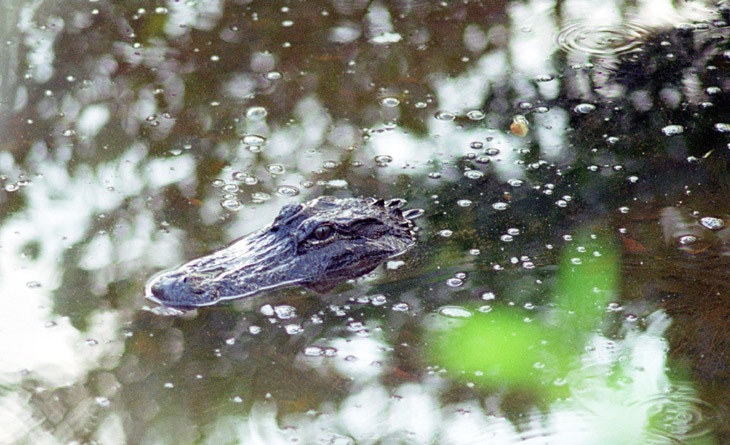
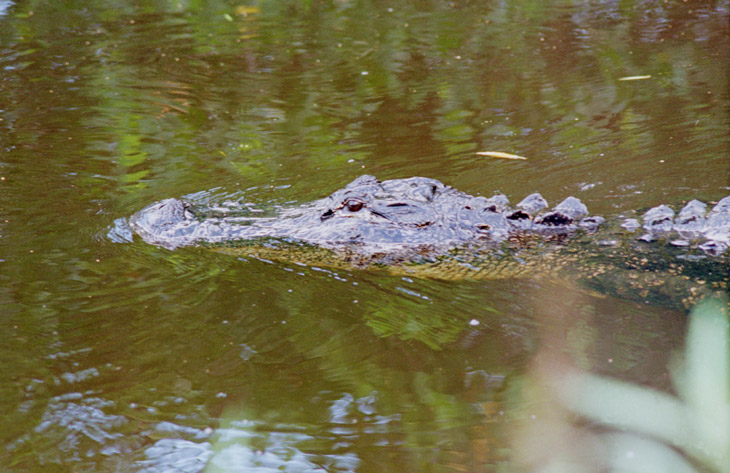




















































 Today’s Monday color was shot exactly one year ago – tomorrow. I say this now so you have time to find a gift.
Today’s Monday color was shot exactly one year ago – tomorrow. I say this now so you have time to find a gift.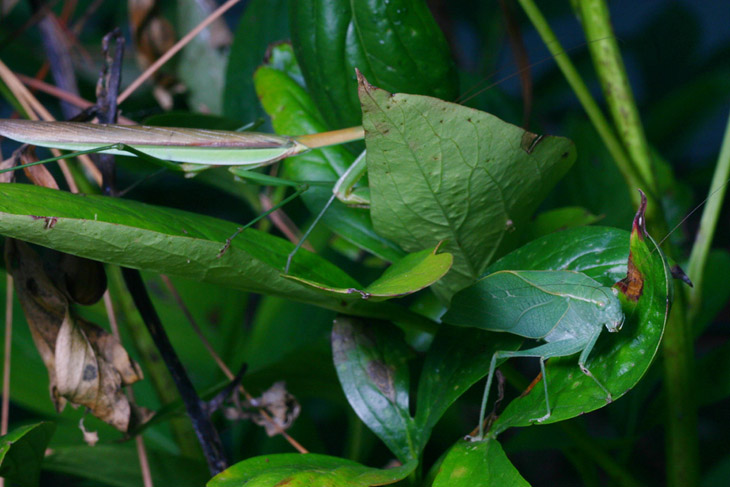

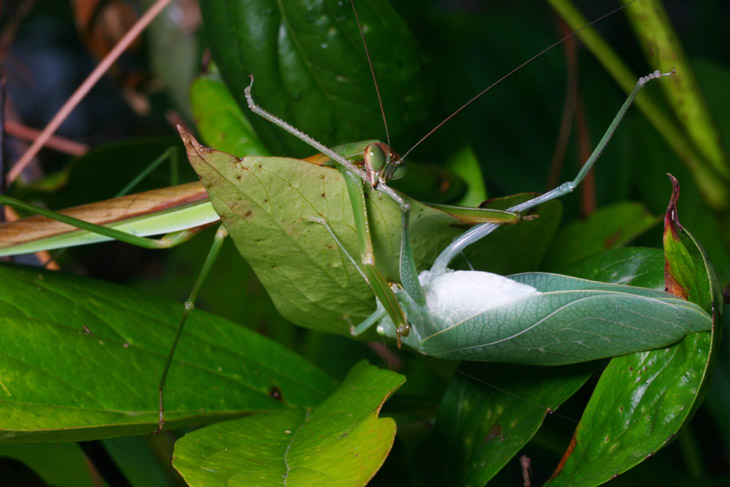




 We continue our quest to catch up with these images from only nine days ago – yeah, make any comments you like – when a torrential rain came through not long before sunset, followed immediately by a break in the clouds. Knowing what that meant, I trotted outside and, sure enough, there was a prominent rainbow, probably the best I’ve ever seen. It was the classic full-on double rainbow right across the sky, except that it was difficult to get it all in view at once, and I didn’t possess a wide-enough lens to do it justice (though I should have grabbed the film body, which didn’t have the crop factor.) After a few quick shots right out in front of the house, I trotted over to the pond and tried for more fartsy shots there, not having a lot of foreground interest to work with – these Canada geese (Branta canadensis) served when the great blue heron refused to pose and I couldn’t find the cormorant.
We continue our quest to catch up with these images from only nine days ago – yeah, make any comments you like – when a torrential rain came through not long before sunset, followed immediately by a break in the clouds. Knowing what that meant, I trotted outside and, sure enough, there was a prominent rainbow, probably the best I’ve ever seen. It was the classic full-on double rainbow right across the sky, except that it was difficult to get it all in view at once, and I didn’t possess a wide-enough lens to do it justice (though I should have grabbed the film body, which didn’t have the crop factor.) After a few quick shots right out in front of the house, I trotted over to the pond and tried for more fartsy shots there, not having a lot of foreground interest to work with – these Canada geese (Branta canadensis) served when the great blue heron refused to pose and I couldn’t find the cormorant.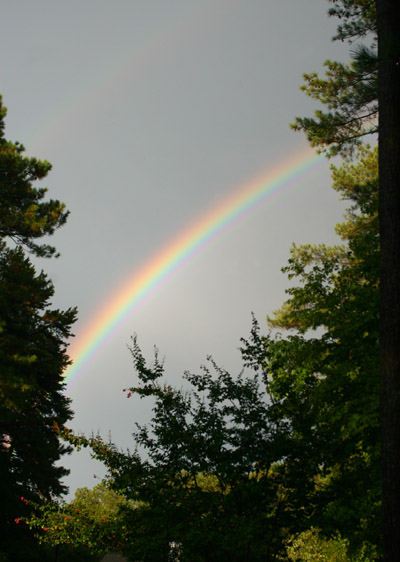 And now for something curious. When I first went outside, the rainbow was at its most brilliant, and there was a particular effect that was actually visible to the eye, though subtly – it was easy to think it might be imagined, but not only did others see it, I captured it in the images. It can, very faintly, be made out here, but stay with me because I’ll show you an enhanced version in a second. For now, look closely at the underside of the lower arc (the upper one is only faintly visible in this image, but it’s there.) Can you make out a faint band of green and a second band of violet down there immediately adjacent, ‘echoing’ the bow? It’s subtle enough here that it could easily disappear depending on your monitor/screen settings, so let’s take a look at an enhanced version from another frame.
And now for something curious. When I first went outside, the rainbow was at its most brilliant, and there was a particular effect that was actually visible to the eye, though subtly – it was easy to think it might be imagined, but not only did others see it, I captured it in the images. It can, very faintly, be made out here, but stay with me because I’ll show you an enhanced version in a second. For now, look closely at the underside of the lower arc (the upper one is only faintly visible in this image, but it’s there.) Can you make out a faint band of green and a second band of violet down there immediately adjacent, ‘echoing’ the bow? It’s subtle enough here that it could easily disappear depending on your monitor/screen settings, so let’s take a look at an enhanced version from another frame.
 As I said, it was difficult to find a lot of foreground interest to put against the bow. The cormorant that I’ve
As I said, it was difficult to find a lot of foreground interest to put against the bow. The cormorant that I’ve 
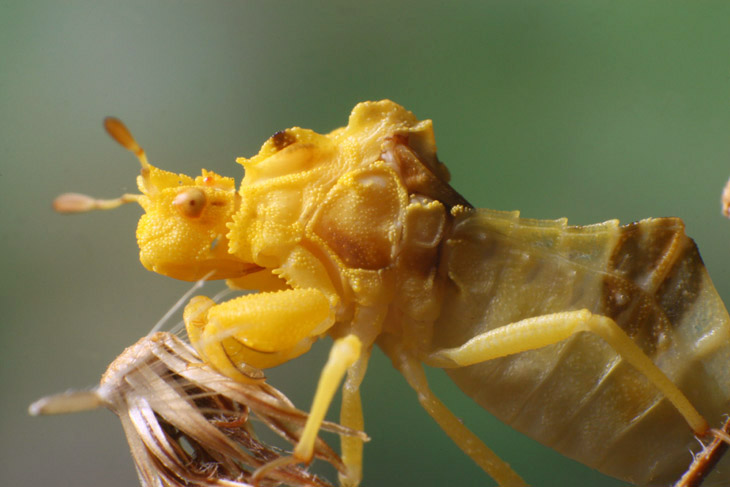
 Ambush bugs are predatory ‘true bugs,’ or Hemipterans, and usually find themselves a perch on a likely flower and await the appearance of pollinators. To say that they are sedentary is perhaps understating it; I have never seen one actually going anyplace, and even when provoked they are reluctant to give up their position. Both of these (if you can’t tell them apart that’s okay, neither can I) possessed wings and yet never made any attempt to fly away. This leads me to speculate that they rely almost entirely on their camouflage and caruncular exoskeleton for defense; usually they blend in much better than this, but we had no yellow flowers around to use as a setting. Also, since a lot of species count on movement rather than appearance in spotting prey, the tendency towards immobility that these bugs appear to possess might be sufficient all by itself. We’ll see more about that shortly. Right now, we’ll go in for a little closer look at the business end of things.
Ambush bugs are predatory ‘true bugs,’ or Hemipterans, and usually find themselves a perch on a likely flower and await the appearance of pollinators. To say that they are sedentary is perhaps understating it; I have never seen one actually going anyplace, and even when provoked they are reluctant to give up their position. Both of these (if you can’t tell them apart that’s okay, neither can I) possessed wings and yet never made any attempt to fly away. This leads me to speculate that they rely almost entirely on their camouflage and caruncular exoskeleton for defense; usually they blend in much better than this, but we had no yellow flowers around to use as a setting. Also, since a lot of species count on movement rather than appearance in spotting prey, the tendency towards immobility that these bugs appear to possess might be sufficient all by itself. We’ll see more about that shortly. Right now, we’ll go in for a little closer look at the business end of things.
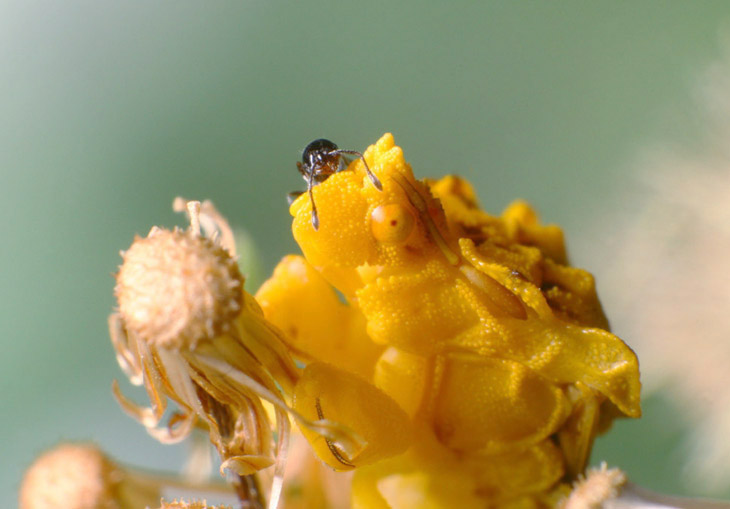
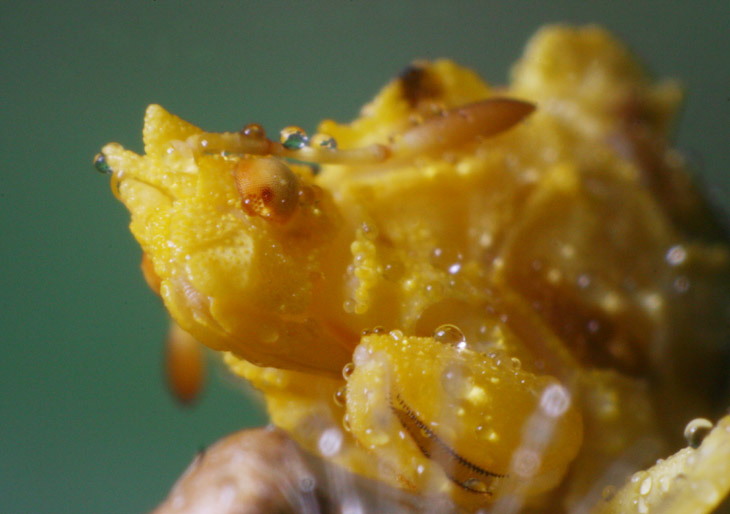
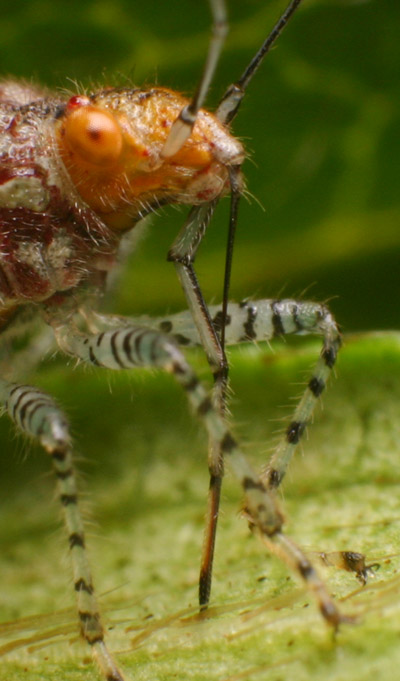 If you look closely at the base of the proboscis in the image above, right at the point of the ‘nose,’ you can see a little gap with a paler, ridged something in there. The proboscis is actually a multi-part appendage, as I discovered by accident in some previous macro pics, prompting me to seek more like the one at left. There is a hard outer ‘cutting/stabbing’ sheath, often articulated, called the labium. Fitting within it are the bits that do the actual drinking, looking like a fine thread even though there are actually four parts, collectively called the stylets, separately a pair each of mandibles and maxillae, terms you might recognize from just about any anatomy lesson, otherwise known as the lower and upper jaws respectively. The separate nature of the labium and stylets is nicely shown with this scentless plant bug (Niesthrea louisianica) that obligingly posed for me while feeding from a leaf. Diagrams and explanations of all this can be
If you look closely at the base of the proboscis in the image above, right at the point of the ‘nose,’ you can see a little gap with a paler, ridged something in there. The proboscis is actually a multi-part appendage, as I discovered by accident in some previous macro pics, prompting me to seek more like the one at left. There is a hard outer ‘cutting/stabbing’ sheath, often articulated, called the labium. Fitting within it are the bits that do the actual drinking, looking like a fine thread even though there are actually four parts, collectively called the stylets, separately a pair each of mandibles and maxillae, terms you might recognize from just about any anatomy lesson, otherwise known as the lower and upper jaws respectively. The separate nature of the labium and stylets is nicely shown with this scentless plant bug (Niesthrea louisianica) that obligingly posed for me while feeding from a leaf. Diagrams and explanations of all this can be 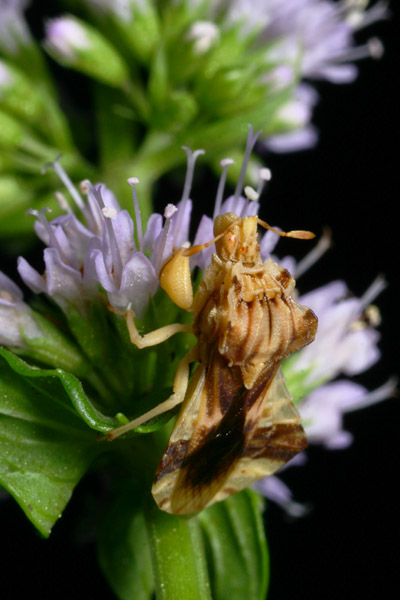 After the photo session, I took both ambush bug specimens out and tried to find appropriate places for them. One went onto the flowers of the spearmint plants, and the other onto a geranium bloom – like I said, we don’t have any yellow flowers around here. The geranium was apparently unacceptable, since I haven’t seen it there since, but the one on the mint seemed to be okay with the choice, considering that it is still there as I type this, a week since its release – that’s it in the pic, obviously not camouflaged terribly well, yet still in flattering colors (if I’m any judge, which I’m probably not.) Faintly visible in this image is the red spot on the back of the ‘skull,’ also visible in one of the photos above and the one with the scentless plant bug. These are small simple eyes called ocelli, primarily believed to help flying insects maintain stable flight. If you roll back a few posts, you can see them on the mantises and the cicada as well.
After the photo session, I took both ambush bug specimens out and tried to find appropriate places for them. One went onto the flowers of the spearmint plants, and the other onto a geranium bloom – like I said, we don’t have any yellow flowers around here. The geranium was apparently unacceptable, since I haven’t seen it there since, but the one on the mint seemed to be okay with the choice, considering that it is still there as I type this, a week since its release – that’s it in the pic, obviously not camouflaged terribly well, yet still in flattering colors (if I’m any judge, which I’m probably not.) Faintly visible in this image is the red spot on the back of the ‘skull,’ also visible in one of the photos above and the one with the scentless plant bug. These are small simple eyes called ocelli, primarily believed to help flying insects maintain stable flight. If you roll back a few posts, you can see them on the mantises and the cicada as well.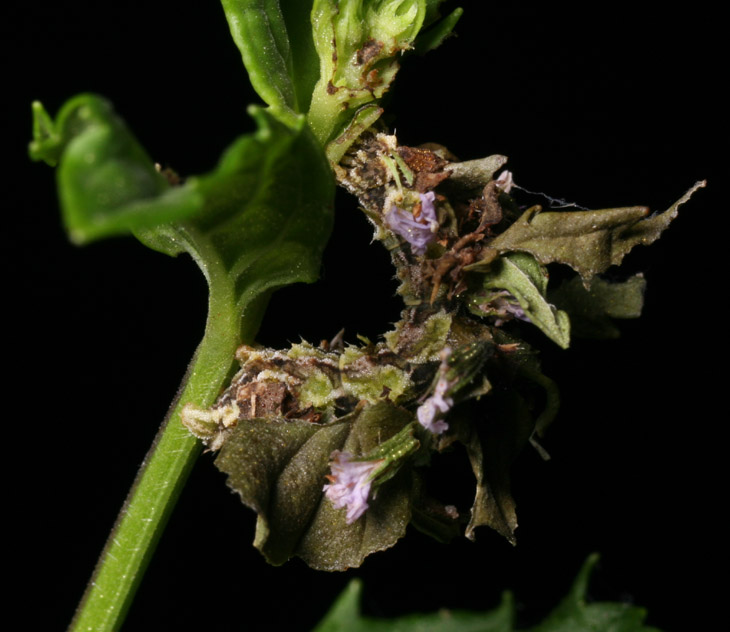


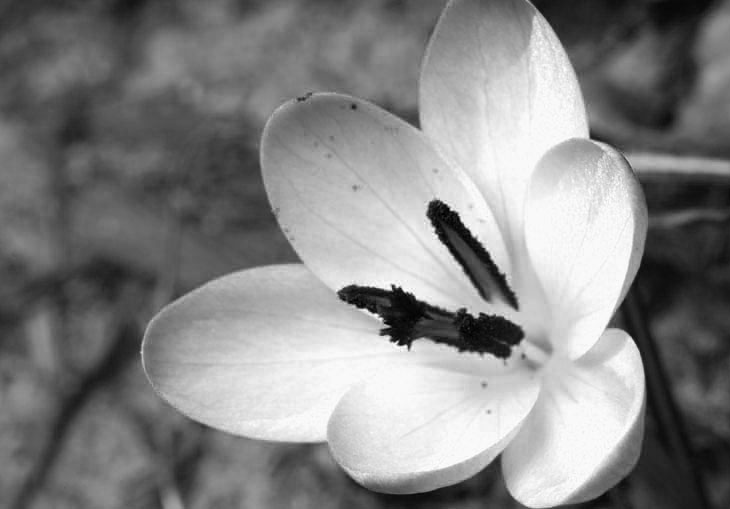
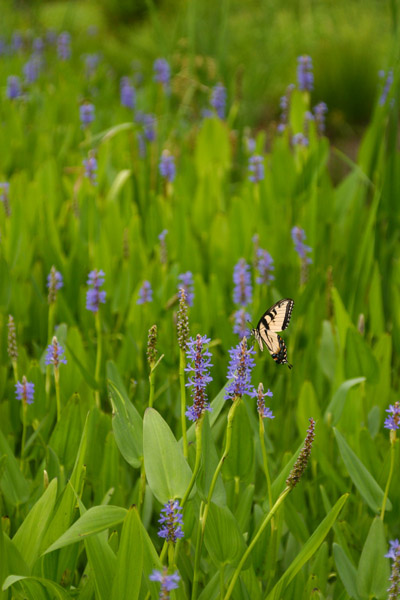 Our attempts to catch up continue, as we hearken back to six days ago and a visit to a nearby pond. A variation of this view was seen
Our attempts to catch up continue, as we hearken back to six days ago and a visit to a nearby pond. A variation of this view was seen  The light was just barely bright enough to shine through the broad leaves, and this suspicious little oval shadow is something that I’ve seen before. Only about the size of the top joint of your thumb, it was the right size and the right shape for a typical position of a treefrog, since they often sit with their legs tucked tightly in, much like cats. This was deep in a thick patch of the water plants, however, and while I could manage a decent view from this side, the other side was going to prove difficult.
The light was just barely bright enough to shine through the broad leaves, and this suspicious little oval shadow is something that I’ve seen before. Only about the size of the top joint of your thumb, it was the right size and the right shape for a typical position of a treefrog, since they often sit with their legs tucked tightly in, much like cats. This was deep in a thick patch of the water plants, however, and while I could manage a decent view from this side, the other side was going to prove difficult.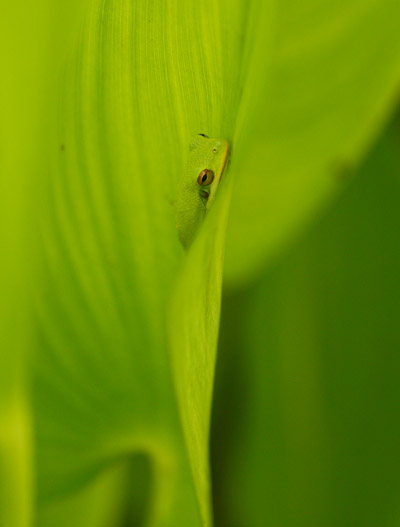 In time, I managed to get to a position that was just barely adequate, seeing through a gap in the surrounding plants right along the edge of the leaf, but enough to reveal that the source of the shadow was exactly as suspected. I told you the color was a close match. This green treefrog (Hyla cinerea) was about half of adult size, being less than 3 cm in body length. I wanted to work with the lower contrast and specific colors of natural light, so I left the flash in the bag, but the overcast conditions meant I was once again shooting mostly at largest aperture (f4 in this case, the wonderful Mamiya 80mm macro that fits on my Canon cameras with a custom mount.) This had the effect that, with the short focus, the frog almost seems to blur into the leaf itself. I might have to do some more experiments with short depth-of-field in these situations…
In time, I managed to get to a position that was just barely adequate, seeing through a gap in the surrounding plants right along the edge of the leaf, but enough to reveal that the source of the shadow was exactly as suspected. I told you the color was a close match. This green treefrog (Hyla cinerea) was about half of adult size, being less than 3 cm in body length. I wanted to work with the lower contrast and specific colors of natural light, so I left the flash in the bag, but the overcast conditions meant I was once again shooting mostly at largest aperture (f4 in this case, the wonderful Mamiya 80mm macro that fits on my Canon cameras with a custom mount.) This had the effect that, with the short focus, the frog almost seems to blur into the leaf itself. I might have to do some more experiments with short depth-of-field in these situations…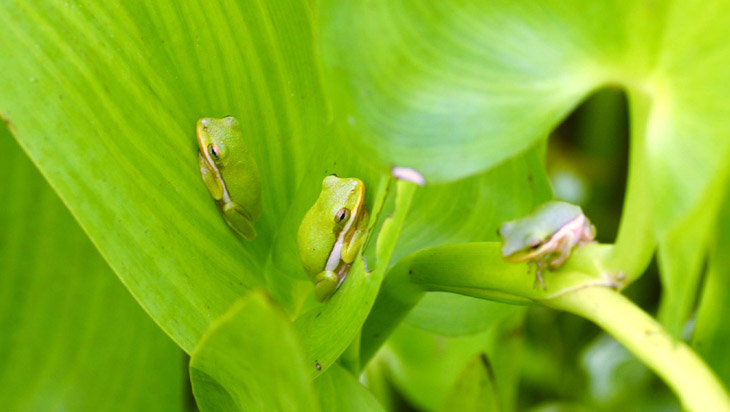
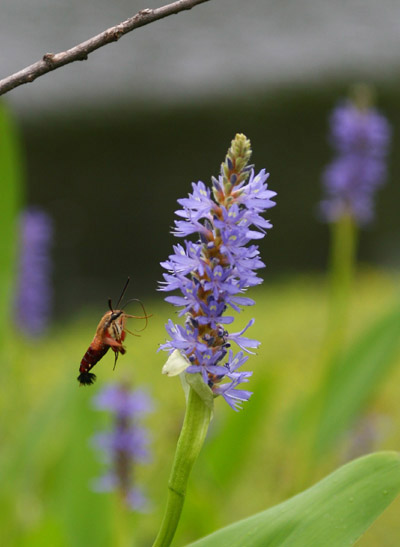 While all of this was going on, I was often in the middle of bumblebees feeding from the flowers, and what I suspect was a solitary clearwing moth, seen several times over. I did not get a close enough image to pin down the exact species (the color of the legs is the key trait,) but I think it was Hemaris thysbe – certainly genus Hemaris, anyway. They’re fun insects to watch, but hyperactive enough to make good photos challenging, not helped at all by the fact that they never land when feeding, instead hovering at the flowers like the hummingbirds that they often mimic. They also mimic bumblebees, and this trait is enough to distinguish them easily because bumblebees always land on the flowers.
While all of this was going on, I was often in the middle of bumblebees feeding from the flowers, and what I suspect was a solitary clearwing moth, seen several times over. I did not get a close enough image to pin down the exact species (the color of the legs is the key trait,) but I think it was Hemaris thysbe – certainly genus Hemaris, anyway. They’re fun insects to watch, but hyperactive enough to make good photos challenging, not helped at all by the fact that they never land when feeding, instead hovering at the flowers like the hummingbirds that they often mimic. They also mimic bumblebees, and this trait is enough to distinguish them easily because bumblebees always land on the flowers. And finally, the last frog captured that morning, in a session that lasted all of fifteen minutes – I just stopped briefly to check on things while running other errands. Yes, this was the last stop before returning home with my filthy feet – I have a little decorum left, and won’t go to public places looking like some derelict. Or even more so than necessary, anyway.
And finally, the last frog captured that morning, in a session that lasted all of fifteen minutes – I just stopped briefly to check on things while running other errands. Yes, this was the last stop before returning home with my filthy feet – I have a little decorum left, and won’t go to public places looking like some derelict. Or even more so than necessary, anyway.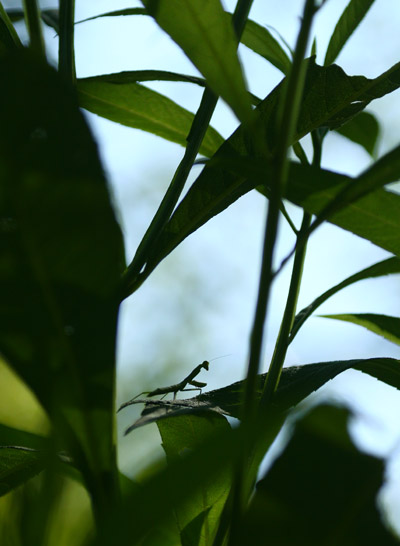 In the past week, I shot about 600 images in four sessions or so, which partially explains the lack of posts. So we’ll play catch-up over a couple of days, and in the process see the difference in approach used, depending on the subject and circumstances.
In the past week, I shot about 600 images in four sessions or so, which partially explains the lack of posts. So we’ll play catch-up over a couple of days, and in the process see the difference in approach used, depending on the subject and circumstances.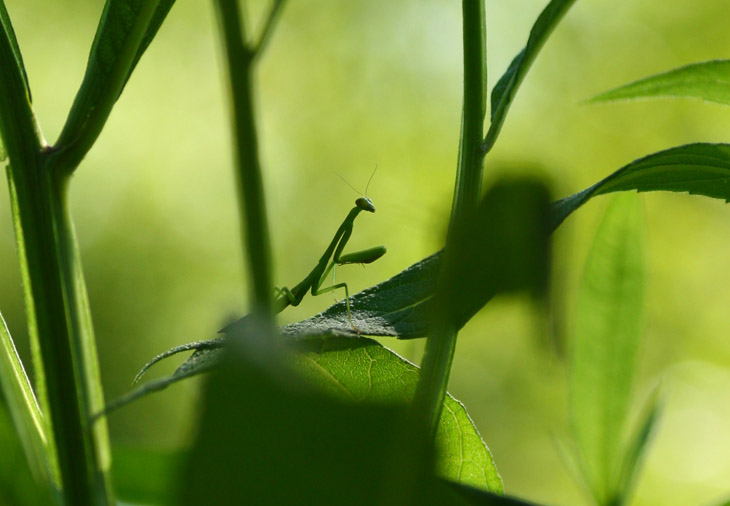
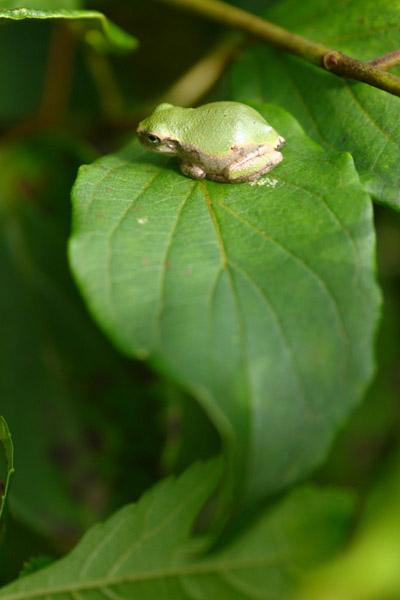 I have a few images of this eentsy treefrog that show the face better, but this one gives a dramatic impression of scale with the entire leaf visible. This is likely a squirrel treefrog (Hyla squirella,) and probably the same species captured
I have a few images of this eentsy treefrog that show the face better, but this one gives a dramatic impression of scale with the entire leaf visible. This is likely a squirrel treefrog (Hyla squirella,) and probably the same species captured 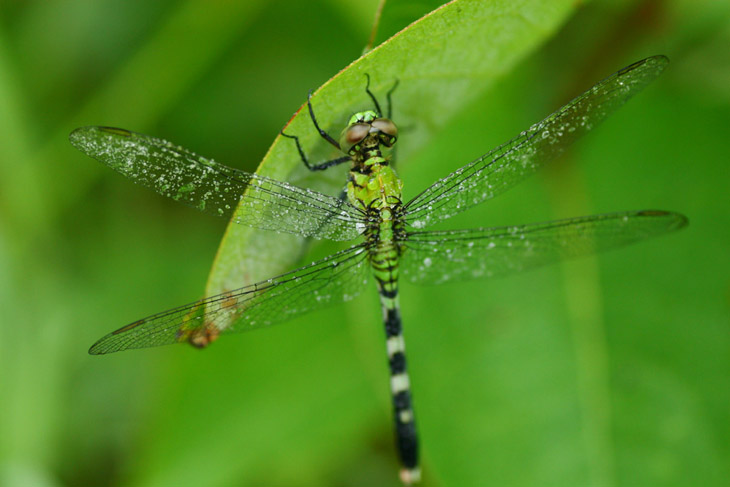
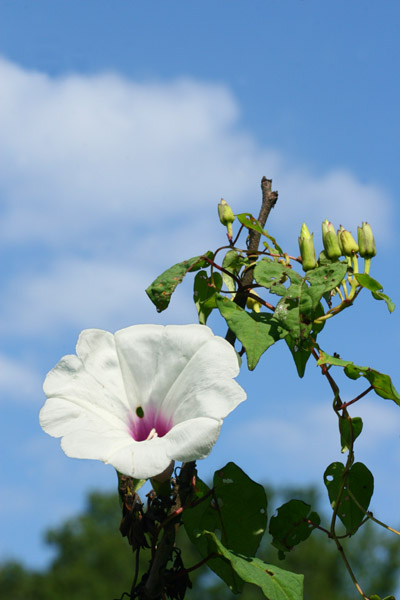 This dragonfly, an eastern pondhawk (Erythemis simplicicollis,) was the first species captured that day, before the sun had risen enough to break through most of the trees and evaporate off the dew – while I admit to plying a misting bottle in situations where it can add to the image, the moisture here is natural, and fairly common with dragonflies in the right conditions. And since dragonflies need a good level of warmth in their wing muscles along the thorax to fly (the reason why they’re always found perching on reeds in bright sunlight,) any this covered in dew are unlikely to fly away at a close approach. However, with a very slow approach, you can actually get them to perch on a fingertip at any time, because they view speed as a threat and glacial movements simply don’t register in this way. Go straight in towards the head, and gently push up against the face or forelegs when you make contact – no, they don’t bite.
This dragonfly, an eastern pondhawk (Erythemis simplicicollis,) was the first species captured that day, before the sun had risen enough to break through most of the trees and evaporate off the dew – while I admit to plying a misting bottle in situations where it can add to the image, the moisture here is natural, and fairly common with dragonflies in the right conditions. And since dragonflies need a good level of warmth in their wing muscles along the thorax to fly (the reason why they’re always found perching on reeds in bright sunlight,) any this covered in dew are unlikely to fly away at a close approach. However, with a very slow approach, you can actually get them to perch on a fingertip at any time, because they view speed as a threat and glacial movements simply don’t register in this way. Go straight in towards the head, and gently push up against the face or forelegs when you make contact – no, they don’t bite.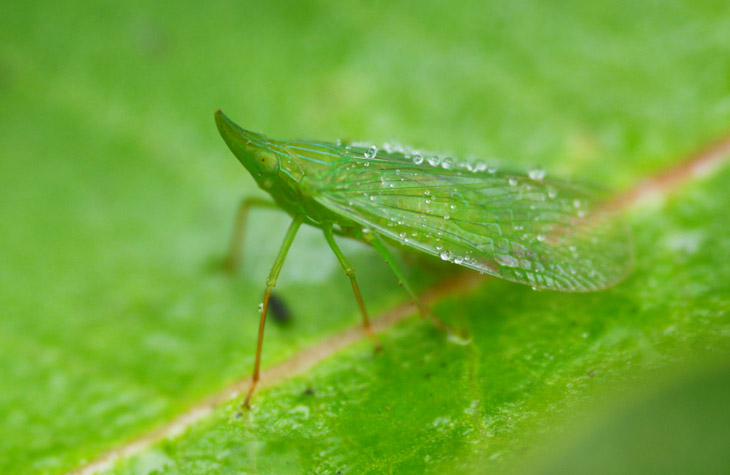
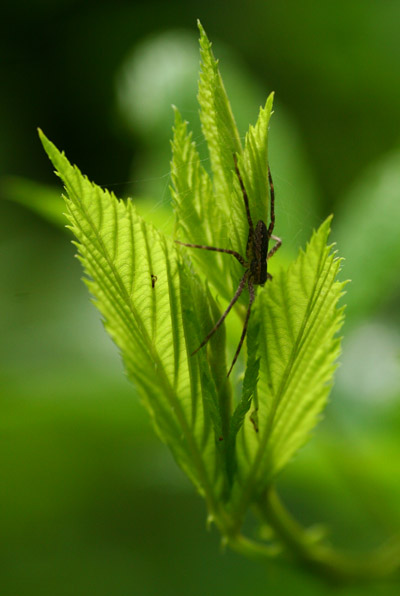 The dew had already boiled off by the time we found several nursery web spiders (Pisaurina mira,) all perched in similar positions atop their own stalks of raspberry plants. To me, there’s something evocative of the early morning sunlight shining through yet the spider appears to be shunning it. While this is likely true, because it will help them avoid birds, I cannot say this definitively, especially since we only had the one angle to work from, so couldn’t test the theory by finding any others on the sunny side of the plants.
The dew had already boiled off by the time we found several nursery web spiders (Pisaurina mira,) all perched in similar positions atop their own stalks of raspberry plants. To me, there’s something evocative of the early morning sunlight shining through yet the spider appears to be shunning it. While this is likely true, because it will help them avoid birds, I cannot say this definitively, especially since we only had the one angle to work from, so couldn’t test the theory by finding any others on the sunny side of the plants.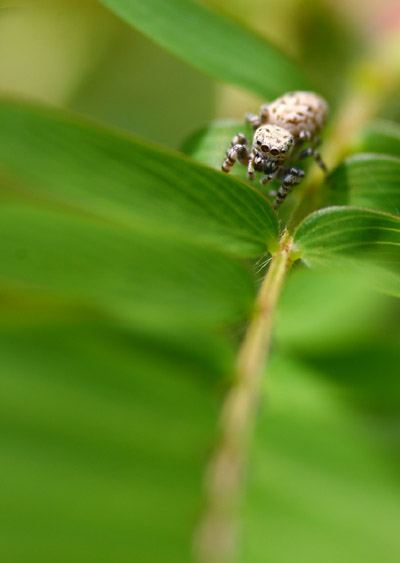 We close with another spider, this one a jumping spider, likely
We close with another spider, this one a jumping spider, likely  I’m sorry, I’m sorry, I’m sorry! I lost track of what day it was and was concentrating on other things, but that’s just pathetic whining under the looming threat of the whip. To try and make up for it, however (now that your day is already off to a bad start,) I humbly offer this remarkably current image, taken less than an hour ago. It’s almost like a Twatter account (or Instagrump or Pisinterest or whatever the hell applies,) but without the soul-destroying lameness.
I’m sorry, I’m sorry, I’m sorry! I lost track of what day it was and was concentrating on other things, but that’s just pathetic whining under the looming threat of the whip. To try and make up for it, however (now that your day is already off to a bad start,) I humbly offer this remarkably current image, taken less than an hour ago. It’s almost like a Twatter account (or Instagrump or Pisinterest or whatever the hell applies,) but without the soul-destroying lameness.